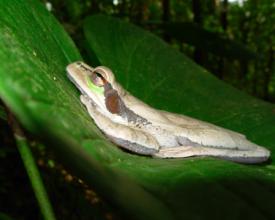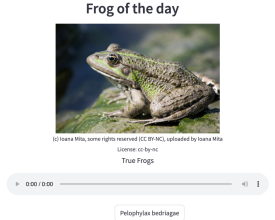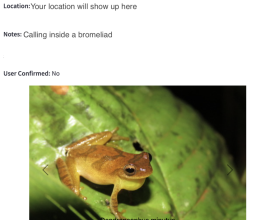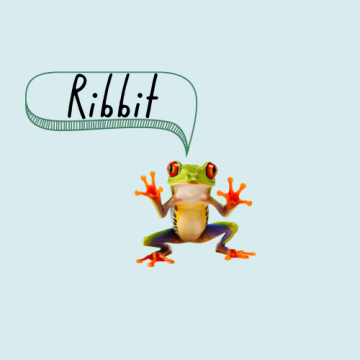
Ribbit - a web app for automated identification and classification of anuran species
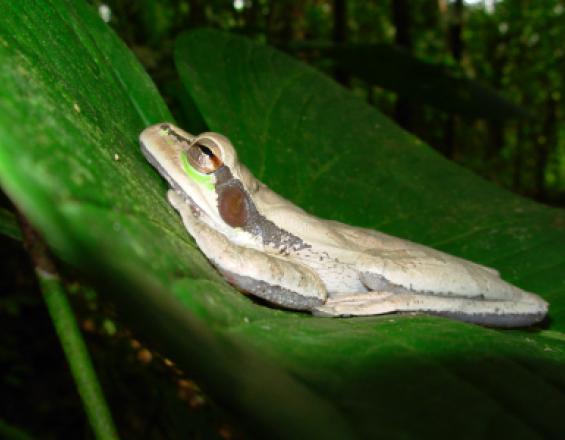
Ribbit is a citizen science web app that uses few-shot transfer machine learning to record, identify, and classify frog and toad calls, contributing crowdsourced data to the Global Biodiversity Information Facility (GBIF) to address data gaps, especially in the Global South. Identification apps offer significant potential for automatic in situ biodiversity monitoring (Global Partnership on Artificial Intelligence, 2022; Tuia et al., 2022; Nieto-Mora et al., 2023). Our app focuses on anurans, as they are crucial ecosystem indicators (Estes-Zumpf et al., 2022), with over 40% of the species at risk of extinction, and their unique vocalizations are ideal for acoustic identification. Beta testers revealed the app's potential to contribute data to GBIF while empowering citizen scientists to engage in ecological monitoring. By creating an open-access platform for labeling biodiversity data, Ribbit enables conservation organizations to develop strategies for protecting vulnerable populations and preserving critical ecosystems.
Context
Challenges addressed
Ribbit addresses critical environmental, social, and economic challenges in biodiversity monitoring. Environmentally, the app tackles data collection gaps (GBF target 14), particularly in the global south. With over 40% of anuran species at risk of extinction (Estes-Zumpf et al., 2022), traditional monitoring methods fail to capture comprehensive ecosystem health and biodiversity changes.
Socially, Ribbit democratizes scientific research by providing accessible ecological monitoring tools for citizen scientists. By empowering citizen scientists, the app breaks down barriers between professional research and community engagement, creating meaningful participation opportunities for individuals to contribute to biodiversity research.
Economically, it offers a cost-effective alternative to resource-intensive traditional monitoring methods. Ribbit leverages crowdsourced data collection and advanced machine learning, reducing research costs, while expanding data collection capabilities for researchers and conservation organizations.
Location
Process
Summary of the process
With mitigating biodiversity loss as our core objective, the other building blocks strategically support this effort. The citizen science approach directly addresses biodiversity challenges by creating a comprehensive data collection mechanism that fills critical knowledge gaps. Through innovative technology, the project transforms individual contributions into a powerful scientific resource for ecological monitoring.
Citizen science and community engagement drives data collection, connecting local participants with global conservation efforts. Ribbit, as an education tool empowers citizens to transform from passive observers into active environmental stewards. The democratization of data collected in the app serves as the critical infrastructure that amplifies the project's impact. By making scientific research accessible and participatory, the solution breaks down traditional barriers between professional researchers and community members. This open-access approach ensures that collected data can be utilized by conservation organizations, researchers, and policymakers, creating a direct pathway from citizen observation to meaningful environmental action.
Building Blocks
Democratization of data
Ribbit's approach to data democratization represents a carefully curated process of citizen-driven scientific contribution. By leveraging existing public datasets from iNaturalist sounds and Anuraset, the application establishes a robust foundation for acoustic biodiversity monitoring. These initial datasets provide a comprehensive baseline for machine learning training, ensuring high-quality initial models for anuran identification.
The application's innovative data collection strategy goes beyond gathering information, implementing a rigorous quality control process for user-contributed data. Each citizen-submitted recording will undergo careful verification before potential contribution to the Global Biodiversity Information Facility (GBIF). This approach transforms passive data collection into an active, collaborative scientific process where citizens can meaningfully contribute to conservation research, addressing GBF Target 14, to "Integrate Biodiversity in Decision-Making at Every Level".
Critically, Ribbit maintains stringent data privacy and protection protocols. Recognizing the sensitive nature of ecological data, particularly regarding rare species and precise location information, the application implements strict user consent mechanisms. No user data will be shared or distributed without explicit, informed approval from the contributor, protecting both ecological subjects and citizen scientists' privacy.
Enabling factors
- Accessible technology: web app runs on desktop and mobile devices, and users may upload their data when no Internet is available.
- Robust quality control mechanisms: advanced evaluation of scientific quality recordings.
- Ethical data governance: prioritization of user privacy and ecological sensitivity.
- Periodical re-training of the model: the model is updated every six months, with training done on new species that are incorporated into the app and validated by annotators.
Lesson learned
When starting this project, we were aware of the anuran biodiversity data gap in the global south. However, we were surprised that as we attempted increase accessibility of our application and add qualitative data, there was a gap in language representation. Currently, our project is available in four languages (English, Spanish, Portuguese, Arabic), increasing accessibility. We used the Wikipedia API to obtain general information about our species in these four languages, and noticed that while there was an abundance of data in English and Arabic, the information available was sparse in Spanish and even more sparse in Portuguese. Therefore, we envision a future challenge will involve engaging diverse scientists, such as Spanish and Portuguese speaking scientists, to decrease the "Wikipedia data gap". Addressing this gap will be a crucial act in further democratizing and increasing accessibility of our solution.
Resources
Citizen science and community engagement
Citizen science apps have been shown to aid in biodiversity monitoring while engaging nature enthusiasts (Callaghan et al., 2019). For instance, FrogID, an app by the Australian Museum, allows users to record frog calls whose identity is verified by human validators. To date, FrogID has published papers related to monitoring invasive species (Rowley and Callaghan, 2023), informing IUCN red list assessments (Gallagher et al., 2024), assessing fire impacts (Mitchell et. al., 2023), understanding urbanization impacts (Callaghan et al., 2020) and studying frog call behavior (Liu et al., 2022). Our goal is to achieve similar results with Ribbit, with anuran species around the world, and in a shorter time frame. To date, the FrogID team has a backlog of over 18,000 calls, which could be greatly reduced with our app, since the processing time is greatly reduced with the implementation of machine learning algorithms.
During the first round of beta testing of our app, 50 users submitted recordings for identification. Their feedback has been positive: subject matter experts have pointed out that the species they recorded matched the one predicted by Ribbit, and nature enthusiasts have enjoyed the "Frog of the Day" feature introducing them to a new anuran species or allowing them to re-acquaint with familiar anurans through name and most common vocalization of the species (GBF target 11).
Enabling factors
- Ease of use: through analyzing feedback from users, we iterated to enhance user experience and accessibility.
- Familiarity of established citizen ecological science apps: with FrogID, Merlin, eBird and iNaturalist used as references, we mimicked key app features for quick initiation for new users.
- For those users who had never had any experience with citizen science applications, we focused on making the app as user-friendly as possible. Additionally, our FAQ section includes tips on "how to frog", including where and when to find calling species.
Lesson learned
- It is hard to strike a balance between different types of users. While scientists advocated for using scientific names, nature enthusiasts did not connect to these names and preferred common names. However, obtaining common names for all our species in all four languages proved to be challenging. This is another opportunity for development: crowdsourcing common names around the world.
In the future, we also want to create more visual content, in order to guide users who want to use the app but are not sure how to do so; this content includes what to include in the optional observations section of the app, how to validate whether the frog suggested by the app is the one the user is seeing, among others.
Resources
Mitigate biodiversity loss
Conserving ecosystems is key to curbing climate change, and maintaining ecosystem services (GBF target 11), which are closely linked to over 50% of the world’s GDP. Over 1 million species face the threat of extinction this century; however, selecting which areas to conserve is challenging with the existing data gap, which is biased towards observations in the global north. Increasing the amount of biodiversity data in the Global South is critical in the conservation of endangered species, found at high density in biodiversity hotspots in the Global South. Amphibians are ideal for acoustic identification due to their diverse vocalizations and are crucial ecosystem indicators (Estes-Zumpf et al., 2022), with over 40% of species at risk of extinction (Cañas et al., 2023). Increasing labeled data for the more than 7,000 amphibian species worldwide would enhance conservation efforts and reduce knowledge gaps in vulnerable ecosystems. By using a citizen science platform to aid in the mitigation of biodiversity loss, we help establish local environmental stewardship of these critical habitats (GBF Target 20).
Other citizen apps have shown the potential that citizen science has on mitigating biodiversity loss. eBird, the largest citizen science project related to biodiversity, has 100 million bird observations from users around the world. These observations help to "document the distribution, abundance, habitat use and bird trends through collected species list, within a simple scientific framework." (Sánchez-Clavijo et. al., 2024).
iNaturalist, another citizen science app, that uses computer vision algorithms for species identification, has also proven successful in mitigating biodiversity loss. To date, the app has over 200,000,000 observations, with 6 million observations per month, globally. On iNaturalist, research-grade observations are shared with GBIF, which in turn uses that knowledge for policy decisions, research, and community building (GBIF, 2023).
Currently, our app identifies 71 species of frogs and toads, worldwide. Though many of them are identified as least concern (LC) under the IUCN, we do have one IUCN endangered species, the Southern Bell Frog (Ranoidea raniformis). This lack of threatened species included, underscores the need for diverse practitioners to participate in bioacoustic ecological monitoring. Increasing data points on vulnerable species can serve to inform policy decisions using data-driven insights. Local communities and Indigenous Peoples will be a key asset in increasing the number of species included in the app, as their local knowledge allows us to track species in remote regions.
Enabling factors
- Closing data gaps: get more data from citizen scientists, especially from local communities and Indigenous Peoples.
- Enabling environmental stewardship: accessibility to a diverse set of users.
Lesson learned
We initially set a goal to decrease data gaps in the Global South. However, getting access to enough calls for rare, cryptic, and endangered species in the Global South to train our model proved to be challenging. Therefore, to improve model performance, we turned our attention to as many species as we could tackle, worldwide. Getting users engaged worldwide will lead to more recordings in data-poor regions like the Global South, allowing us to retrain our model in the future with increased data on endangered, rare, and cryptic species.
This user engagement perfectly aligns with multiple targets, the most evident one being GBF target 20: Strengthen Capacity-Building, Technology Transfer, and Scientific and Technical Cooperation for Biodiversity. But other targets are key in this building block: by increasing the data points, we will be able to identify invasive alien species, addressing GBF Target 6, as well as protecting wild species from illegal trade, by obscuring their location from users. This is aligned with GBF Target 5, which seeks to "Ensure Sustainable, Safe and Legal Harvesting and Trade of Wild Species."
Education tools
Amphibians are more threatened and are declining more rapidly than either birds or mammals. Amphibian populations are decreasing due to multiple factors, such as climate change, the chytrid fungus, and other anthropogenic factors such as species trafficking. However, the level of threat to amphibians is undoubtedly underestimated because 1294 species (22.5%) are too poorly known to assess, as compared with only 78 birds (0.8%) (Stuart et al., 2004).
This knowledge deficit underscores the vital importance of educational tools like Ribbit in democratizing scientific research. By lowering barriers to ecological monitoring, apps like Ribbit transform passive observers into active conservation participants. Educational technologies enable citizen scientists to directly contribute to understanding and protecting vulnerable ecosystems, addressing critical research limitations through expanded data collection in under-researched regions.
These innovative platforms increase public awareness about biodiversity challenges while providing accessible pathways for scientific engagement. Unlike bird-focused apps with well-established research infrastructures, anuran conservation has lacked comprehensive citizen science platforms. Ribbit fills this critical gap by empowering individuals to become crucial contributors to amphibian research, turning the tide on data deficiency and supporting global conservation efforts through collaborative, technology-enabled environmental stewardship. It is the first application to include information about over 800 amphibian species, in four languages, including call type, photo, CITES information (whether species are trafficked or used for commercial purposes, addressing GBF targets 5 and 9), IUCN status (whether species are endangered, addressing GBF target 4) and general information on animal behavior and reproduction.
Enabling factors
- Subject matter expertise: one of our team members (Juliana Gómez Consuegra) worked closely with other experts who were researching the chytrid fungus.
- Creating accessible web app: intuitive design of web app allows less-experienced observers to participate and learn.
Lesson learned
While the goal is to educate nature enthusiasts, we want to avoid the increase of species trafficking. For this reason, we decided not to allow users to have access to each other's data. That way, an endangered species' location won't be visible to traffickers, on the app. Users only have access to their own data. Once data is shared with GBIF, the data is obscured, so that neither the frog's nor the user's precise location will be disclosed to the general public. This way, we are ensuring that our application is environmentally responsible.
Impacts
Ribbit demonstrates positive impacts across environmental, social, and economic domains. Environmentally, Ribbit was trained on 71 distinct anuran species, creating a comprehensive tool for monitoring endangered amphibian populations. Beta-testing successfully recorded and classified 16 distinct anurans, with the model accurately identifying species in the top-5 most-likely matches 91% of the time, comparable to other transfer learning solutions for bioacoustics (Ghani et al., 2023). Utilizing a dataset of ~67,000 unique Anura calls, Ribbit enables identification of potential habitat shifts and population changes in understudied regions.
Socially, Ribbit's beta testing engaged 50 participants, creating a new pathway for community-driven scientific research. The platform democratizes data collection, reducing barriers to ecological research participation. 95% of surveyed users were willing to share their recordings with GBIF, contributing to global biodiversity data.
Economically, Ribbit significantly reduces monitoring costs. Traditional biodiversity monitoring for 50 locations would cost approximately $118,413 USD, including equipment, labor, and data analysis. In contrast, Ribbit's monthly operational cost is estimated at $48,543.77, including AWS infrastructure and skilled personnel. This cost-effective approach allows practitioners to focus resources on conservation actions based on collected data.
Beneficiaries
Ribbit benefits citizen scientists through research participation, local communities through ecological monitoring, and conservation researchers through additional anuran data collection in previously under-researched, but biodiversity-rich ecosystems.
Additionally, explain the scalability potential of your Solution. Can it be replicated or expanded to other regions or ecosystem?
Ribbit's solution demonstrates significant scalability potential through its innovative machine learning approach, specifically designed to adapt and improve with increasingly diverse data inputs. The few-shot transfer learning model can be systematically expanded to other amphibian-rich ecosystems globally, with particular applicability in biodiversity hotspots across tropical and subtropical regions.
The core technological architecture is inherently adaptable, allowing for seamless integration of acoustic data from different geographic contexts. As more diverse anuran call recordings are collected from varied ecosystems, the machine learning model can be supplemented to progressively become more sophisticated, enhancing its identification accuracy and expanding its species recognition capabilities. This improving mechanism means that each new data contribution not only adds to scientific knowledge but also refines the technological platform's performance.
The potential for replication extends across multiple domains. The platform could be adapted for other acoustically distinctive animal groups, enabling similar monitoring approaches for insects, or mammals. Additionally, the technology allows for developing region-specific modules that can be customized for local ecological contexts, creating flexible research tools that respond to specific environmental needs. By fostering collaborative research networks that can share data and model improvements, Ribbit provides a framework for expanding scientific understanding across institutional and geographic boundaries.
The solution's open-access approach and modular design make it particularly well-suited for global scaling. By prioritizing user accessibility, scientific rigor, and continuous learning, Ribbit provides a replicable model for technology-enabled biodiversity monitoring that can be tailored to diverse ecological research needs.
Global Biodiversity Framework (GBF)
Sustainable Development Goals
Story

Doing field research in the Colombian rainforest can be challenging. A Relative Humidity of 100% means that your field equipment needs to be kept in silica to survive. The lack of electricity means that your recording devices may not charge in time for your next recording session. And, depending on the time you went to the field, security concerns were high, due to the ongoing civil war. I experienced all of these situations during 2007, when I was pursuing my master’s in biology, and researching homing behavior in poison frogs. My daily tasks included walking an hour each way, every day, to and from my field site; setting up speakers that played back frog sounds to see how males of the harlequin poison frog would react to changes in their environment. My only companion was Yaz, a local member of the community, whose life story was inspiring to me. He went from scraping coca leaves for the armed rebel groups to working at an NGO, to creating his eco-lodge where people can go on frog-watching expeditions. When I learned of his most recent endeavor, I thought to myself: What if we could combine an exotic trip to the rainforest with a contribution to science? So I reached out to my biologist colleagues and pitched them my idea for a citizen science app that would automatically identify a calling frog. Below is the feedback from one of them:
“I want to congratulate you on the development of Ribbit. I am a biodiversity scientist working in Colombia, and have had the opportunity of witnessing firsthand the impact that eBird has had on the monitoring, and the social appropriation of birds in Colombia and people always ask… why only birds? My answer is usually because they are the easiest for non-scientists to encounter and identify but through apps like Ribbit this does not need to be the case forever!
Relying on sounds for identification, which are a lot easier to record with a regular phone vs trying to take an actual picture of a frog in the wild, is an excellent idea, and just like it happened with eBird, the more that people use the app, the better the information it will provide. A question as “simple” as what species live where/when is still a challenge in megadiverse countries like Colombia, so all data generated by Ribbit will be useful in meeting this challenge.
Keep working hard and let us know if we can help in any way.”
Lina M Sánchez-Clavijo, PhD
Principal Researcher
Scientific Information Office
Instituto Humboldt
Testimony by: Juliana Gómez Consuegra, Ribbit team lead


